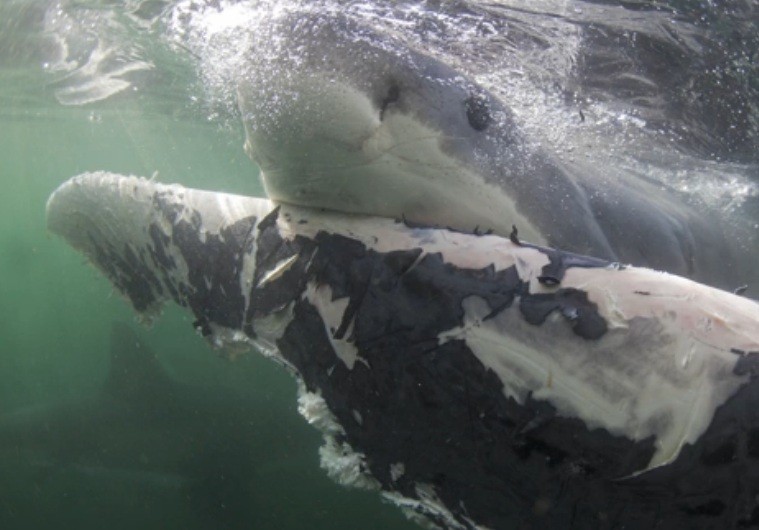Great White Sharks Scavenging On Dead Whales

Many terrestrial animals are frequently observed scavenging on other animals– whether it is a hyena stealing a lion kill in the Serengeti or a buzzard swooping down on a dead animal. However, documenting this sort of activity in the oceans is especially difficult, and often overlooked in marine food web studies.
In a new study published in PLOS ONE titled, "White sharks (Carcharodon carcharias) scavenging on whales and its potential role in further shaping the ecology of an apex predator," Captain Chris Fallows from Apex Expeditions collaborated with University of Miami (UM) scientists Dr. Neil Hammerschlag and Austin Gallagher, to explore the behaviors of Great white sharks scavenging on dead whales in South Africa. The team documented as many as 40 different sharks scavenging on a carcass over the course of a single day, revealing unique social interactions among sharks.
The study summarized observations based on four scavenging events opportunistically observed over a 10 year period. In each multi-day observation, the team recorded daily evidence of social, aggregative and feeding behaviors observed in the waters off South Africa. They suggest that although the occurrence of coming upon a whale carcass may be sporadic, the shark populations are likely prepared to scavenge on them, and may even rely on their scavenging activities to supplement their regular feeding activities.
"Although rarely seen, we suspect that as white sharks mature, scavenging on whales becomes more prevalent and significant to these species than previously thought," said Hammerschlag, who is director of the R.J. Dunlap Marine Conservation Program at UM.
The team found that sharks showed a clear preference for scavenging on the blubber, probably because these high calorie meals can sustain the sharks for longer periods of time. Interestingly, though, the study also found that sharks showed an initial preference for feeding on the whale's fluke before moving on to feed on the rest of the carcass. The team also found that while scavenging on whales, they ceased hunting and feeding on seals, one of their primary natural prey.
"While scavenging on the whale, the sharks clearly showed a size-based pecking order," said Fallows. "The biggest sharks came right in, targeting areas of highest blubber content, while smaller sharks fed on areas with less blubber or kept their distance from the whale, mostly scavenging on pieces of blubber that drifted away from the carcass."
The paper reveals how the social and size structure of sharks at the carcass appeared to be influenced by environmental patterns. "The cues, such as the oils, emanating from this pulse of food are likely attracting much larger sharks over 4.5 meters from long distances to scavenge," said Gallagher. "These data provide some credence to the hypothesis that large white sharks may be swimming known ocean corridors looking for dead, dying, or vulnerable whales."
"By attracting many large white sharks together to scavenge, we suspect that the appearance of a whale carcass can play a role in shaping the behaviors, movements, and the ecosystem impacts of white sharks" said Hammerschlag. "These patterns may shed some light into the ecology of this often studied - yet still highly enigmatic - marine predator."



